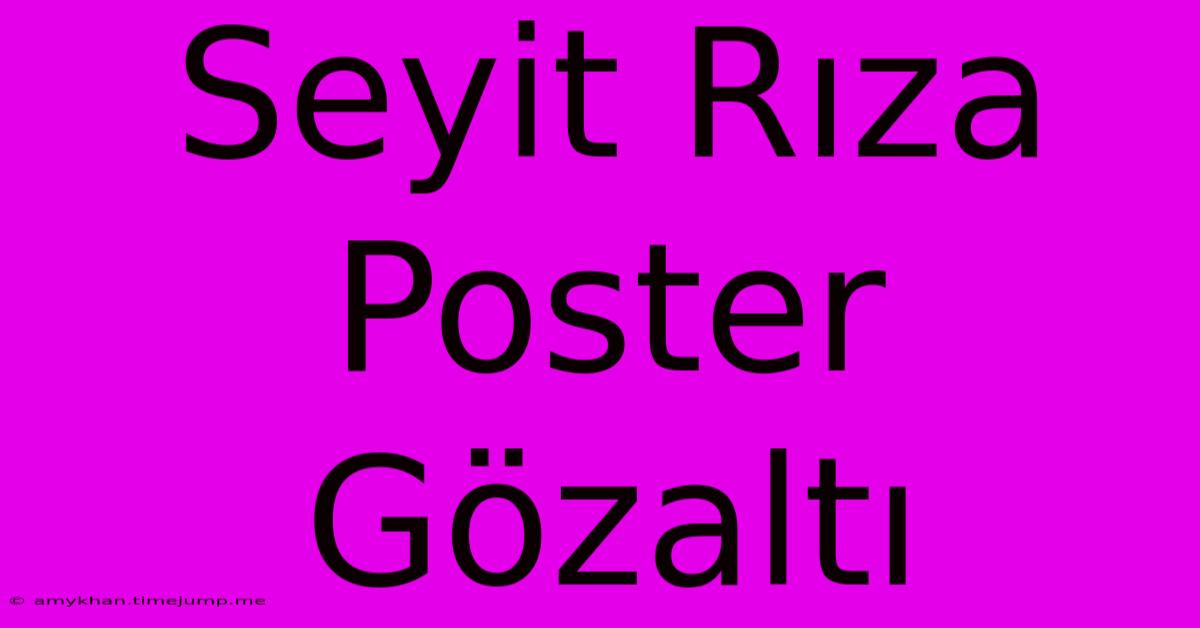Seyit Rıza Poster Gözaltı

Discover more detailed and exciting information on our website. Click the link below to start your adventure: Visit Best Website Slync. Don't miss out!
Table of Contents
Seyit Rıza Poster: A Glimpse into Kurdish Resistance and Political Repression
The arrest of Seyit Rıza, a prominent Kurdish leader, remains a significant event in Turkish history, symbolizing the complex relationship between the Turkish state and the Kurdish people. While precise details of his arrest remain debated, its impact resonates powerfully, often depicted through imagery like posters. These posters, while not always readily available online, offer a visual narrative of this historical moment and its enduring legacy. Let's explore the significance of Seyit Rıza, his arrest, and the potential role of posters in representing this pivotal event.
Who Was Seyit Rıza?
Seyit Rıza (1863-1937) was a Kurdish tribal leader and religious figure in the Dersim region (now Tunceli Province) of eastern Turkey. He played a significant role in resisting the assimilationist policies of the Turkish government, which sought to suppress Kurdish identity and culture. He's often remembered as a symbol of Kurdish resistance against state oppression. His defiance, rooted in his religious authority and tribal leadership, challenged the centralized power of the Turkish state during a period of intense political transformation.
The Arrest and its Significance: The Seyit Rıza Poster Context
The circumstances surrounding Seyit Rıza's arrest are subject to varying interpretations, but his capture marked a turning point in the Dersim region's struggle for autonomy. It was part of a broader campaign by the Turkish government to consolidate its control over the region, a campaign that included forceful assimilation and the suppression of Kurdish cultural expression. The arrest itself likely involved military intervention and reflects the fraught political climate of the time. The depiction of this arrest, or the aftermath, in posters, serves as a powerful visual representation of this power dynamic.
While specific posters related to Seyit Rıza's arrest may be rare and not widely circulated digitally, their hypothetical existence offers crucial insights into how the event was potentially framed and remembered. Imagine a poster showcasing:
- A stylized portrait of Seyit Rıza: conveying strength, defiance, and perhaps even a hint of religious authority.
- Images of Turkish military forces: highlighting the power imbalance and the state's role in the arrest.
- Symbolic imagery: possibly including mountains, representing the rugged terrain of Dersim, or traditional Kurdish clothing, representing cultural identity under threat.
These hypothetical visual elements would not only illustrate the event but also serve as a platform for expressing political viewpoints, contributing to the ongoing narrative surrounding Seyit Rıza's legacy.
The Enduring Legacy: More than just a Poster
Seyit Rıza's story, regardless of specific poster representations, continues to inspire and provoke discussion. He is remembered as a champion of Kurdish rights and a symbol of resistance against oppression. The historical narrative surrounding his life and his arrest continues to be interpreted and debated. The search for visual representations like posters adds another layer to this ongoing engagement with history and its complexities. His legacy fuels ongoing conversations about Kurdish identity, autonomy, and the dynamics of power in the region.
Finding and Researching Materials
Finding posters directly related to Seyit Rıza's arrest might prove challenging. Libraries specializing in Turkish and Kurdish history, archives related to the Dersim region, and potentially private collections are places to explore. Online archives and digital repositories could also yield results, though this may require significant research. The investigation into the existence and imagery of such posters itself becomes a worthwhile historical pursuit.
This exploration of Seyit Rıza's arrest, and the potential of accompanying posters, serves as a window into a complex and often overlooked aspect of Turkish and Kurdish history. The search for visual materials like posters illuminates not just the event itself but also the ways in which history is remembered, interpreted, and contested.

Thank you for visiting our website wich cover about Seyit Rıza Poster Gözaltı. We hope the information provided has been useful to you. Feel free to contact us if you have any questions or need further assistance. See you next time and dont miss to bookmark.
Also read the following articles
| Article Title | Date |
|---|---|
| Karaman Olay Hakkinda Konustu | Dec 13, 2024 |
| Slavia Prag Anderlecht Mac Bilgileri Uefa Avrupa Ligi | Dec 13, 2024 |
| Ronaldo Nun Paylasimi Bueyuek Uezuentue Yaratti | Dec 13, 2024 |
| Fidan Ve Blinken Bir Araya Geldi | Dec 13, 2024 |
| Uezuecue Haber Ronaldo Nun Yeni Paylasimi | Dec 13, 2024 |
